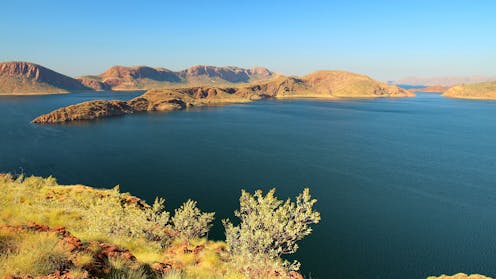Australia’s green hydrogen targets could require vastly more water than the government hopes
- Written by Madoc Sheehan, Adjunct Associate Professor in Chemical Engineering, James Cook University

Green hydrogen is touted by some as the future – a way for Australia to slowly replace its reliance on fossil fuel exports. The energy-dense gas has the potential to reduce emissions in sectors challenging to decarbonise, such as steelmaking and fertiliser manufacturing.
The Albanese government wants it to be a massive new export industry and has laid out a pathway through its National Hydrogen Strategy.
Unfortunately, there’s a real gap between rhetoric and reality. Despite ambitious plans, no green hydrogen project has yet succeeded in Australia. The technology’s most prominent local backer, billionaire miner Twiggy Forrest, has dialled down his ambition. Globally, just 7% of announced green hydrogen projects are up and running.
Economic viability is one problem. But there’s a much larger issue flying under the radar: water. Hitting the 2050 target of 15 million to 30 million tonnes of hydrogen a year would use 7–15% of the amount Australia’s households, farms, mines and black coal power plants use annually. That’s simply not sustainable.
Splitting water
Green hydrogen uses renewable energy to power electrolyser machines, which split water molecules into hydrogen and oxygen.
On the surface, this is an appealing use of clean energy, especially during solar peak periods.
But what the government hasn’t properly accounted for is the water cost for green hydrogen. The strategy states water use is likely to be “considerable but not prohibitive”.
This is questionable. For every kilogram of hydrogen produced through electrolysis, nine litres of water are directly consumed.
That’s not all. The water needed to make hydrogen has to be extremely pure. Salt water has to be desalinated, and even fresh water needs purification. Equipment also needs cooling, which consumes even more water.
All these processes incur substantial indirect water losses, such as the water used for industrial processes and cooling. The volumes used are highly uncertain. They can be up to 20 times greater than the direct water use.
A key input value for the government’s hydrogen strategy modelling is taken from a 2015 report by the Argonne National Energy Laboratory in the United States, which assumes each kilogram of green hydrogen produced requires just over 30 litres of water.
The Australian hydrogen strategy suggests 30 litres per kilogram of hydrogen would cover “all system losses including purification processes and cooling water required”. But it’s not clear if this figure covers other uses of water in making hydrogen, such as water treatment.
How much water would this use?
According to the government’s modelling, making 15 million tonnes would require 740 billion litres of water. That would be about 7% of the 10,450 billion litres used by all of Australia’s households, farms, mines and black coal power plants.
That’s substantial. One and a half Sydney Harbours worth, every year. But it might be a major underestimate. After all, estimates on indirect water use differ widely. The government’s figures are at the very bottom of the range.
For instance, the latest research gives water consumption figures of about 66 litres per kilogram – more than twice as large. Other sources give values between 90 and 300 litres per kilogram of hydrogen – three to ten times higher.
Uncertainty in modelling is normal. But the wide research suggesting much higher water use should give rise to real concern.
If we take a middle-of-the-range figure of 95 litres per kilogram, this would mean that making 15 million tonnes of green hydrogen would use up 22% of the 10,450 billion litres used by households, farms, mines and black coal power plants annually by 2050.
If hydrogen was even thirstier at 310 litres per kilogram, that would translate to 72% of that figure.
These estimates are enormous. Even under the most optimistic scenario, the draw on Australia’s scarce freshwater resources would simply be too much. Where would this water come from? Farmers? Groundwater? Environmental flows from rivers?
As the Queensland Farmers Federation pointed out in its response to the hydrogen strategy, the figures on water use “beg the question if they are in fact sustainable”.
The Water Services Association of Australia has called for much greater attention to the water demands of green hydrogen, which it says are “often seriously underestimated”.
What about saltwater? Australia has no shortage of oceans. The problem here becomes energy and wastewater. Desalination is still very energy intensive. Converting saltwater to fresh also produces large volumes of super-salty brine, which must then be managed as waste.
Which way forward?
Does this mean green hydrogen is a non-starter? Not necessarily. Improved electrolyser technology might offer ways to slash water use, while circular economy approaches such as resource recovery from brine could also reduce losses.
But these concerns about water must be front and centre in future discussions about the shape and size of the industry in Australia.
Authors: Madoc Sheehan, Adjunct Associate Professor in Chemical Engineering, James Cook University



















